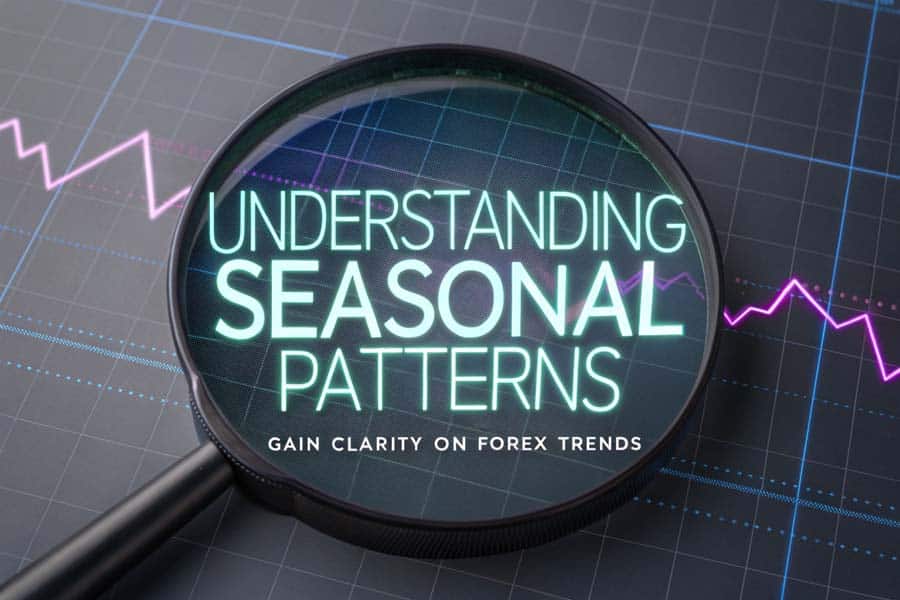Ever wondered how top traders consistently capitalize on forex trends? Understanding seasonal patterns in forex might be their secret weapon.

The forex market is a vast, dynamic arena where trillions of dollars are exchanged daily. Navigating this complex environment can be challenging, even for seasoned traders. However, one powerful yet often underutilized tool can give you an edge: the analysis of seasonal patterns in forex trading. These patterns, influenced by recurring economic cycles, political events, and cultural phenomena, provide valuable insights into market movements. By recognizing and leveraging these forex seasonal trends, you can refine your strategy, improve risk management, and potentially boost your profits—all while trading with a regulated forex broker that ensures a secure and transparent trading environment.
Introduction: What Are Seasonal Patterns in Forex?
Seasonal patterns in forex refer to predictable fluctuations in currency values that occur at specific times of the year. These patterns arise from factors like fiscal policies, trade balances, economic cycles, and significant global events. For example, a currency might strengthen during its country’s peak tourism season due to increased demand from foreign visitors or weaken during periods of political uncertainty.

Discover how seasonal patterns in forex reveal recurring market trends.
Understanding these seasonal forex market patterns is crucial for traders of all levels. It allows for better timing of trades, improved risk management, and the ability to capitalize on predictable market movements, enhancing decision-making and increasing the potential for higher returns. Partnering with a regulated forex broker ensures access to reliable market data, advanced trading platforms, and the necessary tools to effectively implement seasonality into your trading strategy.
Read More: Demo vs Live Forex Trading
Why Seasonal Patterns Matter to Forex Traders

Seasonal patterns give forex traders a competitive edge in predicting market shifts.
Seasoned traders utilize currency seasonality in forex trading to anticipate market shifts, adjust strategies, and optimize portfolios. Recognizing these patterns offers several key benefits:
Enhanced Forecasting
Seasonal patterns provide historical data that improve the accuracy of market predictions. By analyzing past performance during specific periods, traders identify trends likely to repeat, offering a predictive edge in anticipating future price movements.
Risk Management
Anticipating periods of volatility helps implement protective measures. Knowing when a currency pair is likely to experience increased volatility allows traders to adjust their risk management strategies, such as setting stop-loss orders or reducing position sizes.
Maximized Returns
Aligning trades with seasonal trends can lead to more profitable outcomes. Timing entries and exits to coincide with seasonal patterns increases the chances of capturing significant market moves, enhancing profit potential while reducing unfavorable trades.
Incorporating seasonality into your trading strategy bridges the gap between guesswork and informed decision-making, providing a solid foundation for consistent trading success.
Understanding Seasonal Patterns in Forex
To effectively leverage seasonal patterns in forex, it’s essential to understand what they are and why they occur.

Gain clarity on forex trends by understanding seasonal patterns.
Seasonal Patterns Defined
In the forex market, seasonal patterns are recurring movements in currency exchange rates that happen at the same time every year. These patterns are driven by:
- Fiscal Policy Cycles: Government budgeting periods and fiscal year-ends influence currency demand and supply. For instance, corporations may repatriate profits at fiscal year-end, increasing demand for their home currency.
- Trade Balances: Seasonal fluctuations in imports and exports affect currency values. Commodity exporters might see their currencies strengthen during harvest seasons due to increased foreign demand.
- Market Holidays: Reduced trading activity during holidays can lead to predictable market behavior, affecting liquidity and volatility.
Types of Seasonal Patterns in Forex
Seasonal patterns can be observed on both monthly and quarterly bases, each influenced by different factors.
Monthly Trends
Certain currencies exhibit strength or weakness during specific months due to various economic activities.
- Economic Data Releases: Regular reports like employment figures and GDP growth are scheduled at specific times, impacting market sentiment.
- Tax Deadlines: Financial activities around tax payments affect currency flows as individuals and businesses convert assets to local currency.
- Corporate Earnings Reports: Multinational corporations may exchange foreign earnings into their home currency during earnings season, influencing currency demand.
Quarterly Patterns
End-of-quarter activities can significantly impact currency values.
- Financial Reporting: Companies adjust their currency holdings for balance sheet presentations, affecting supply and demand dynamics.
- Portfolio Rebalancing: Institutional investors rebalance portfolios to meet quarterly targets, leading to substantial currency transactions.
Pro Tip: Utilize historical data and advanced analytical tools provided by your online forex broker to identify the best times to trade specific currency pairs, optimizing your strategy for seasonal trends.
Read More: best time frame to trade forex
Key Seasonal Patterns Observed in Forex Markets
Several well-documented seasonal patterns offer valuable trading opportunities.

Identify key seasonal patterns to refine your forex market strategy.
Winter and Year-End Movements
The end of the year is a critical period in forex due to increased liquidity and significant fiscal activities.
- Holiday Seasons: Consumer spending surges during holidays like Christmas and New Year, particularly in retail-heavy economies, strengthening domestic currencies.
- Tourism Impact: Countries popular as holiday destinations may see increased demand for their currency as tourists exchange money.
- Fiscal Year-End Activities: Companies and governments finalize budgets and financials, leading to heightened market movements.
- The December Effect: Investor sentiment shifts based on year-end financial adjustments, potentially causing market rallies or declines.
Monitoring these factors during year-end can help traders capitalize on predictable market movements.
Summer Trading Lull
Known as the “summer doldrums,” this period is characterized by decreased market activity and liquidity.
- Lower Trading Volumes: Many traders and institutional investors take vacations, leading to thinner trading volumes.
- Reduced Volatility: Fewer participants result in less dramatic price movements, affecting short-term trading opportunities.
- Opportunities in Calm Markets: Traders may adjust strategies to capitalize on range-bound markets typical during this period, focusing on technical indicators that perform well in low-volatility environments.
Understanding the summer lull helps traders adjust expectations and strategies to suit market conditions.
Spring and Fall Currency Fluctuations
These seasons often bring unique market dynamics due to various economic activities and events.
- Portfolio Rebalancing: Investors adjust their portfolios at the end of the first and third quarters, impacting currency demand as they adjust holdings in different regions.
- Tax Influences: Fiscal deadlines and corporate tax obligations can lead to increased financial transactions, affecting currency values.
- Volatility Spikes: Political events, elections, and key economic indicators released during these times can cause significant market shifts.
Being aware of these factors enables traders to prepare for potential volatility and adjust their strategies accordingly.
How Economic Cycles and Global Events Influence Seasonality
Seasonal patterns are deeply intertwined with the broader economic environment.

See how economic cycles and global events shape forex seasonality.
Role of Economic Cycles
Recurring economic cycles significantly impact currency performance, creating seasonal patterns.
- Business Cycles: During economic expansion, increased business activity can strengthen a country’s currency. Conversely, during contractions or recessions, currencies may weaken as investors seek safer assets.
- Central Bank Policies: Adjustments in interest rates and monetary policies in response to economic conditions directly influence currency values. Rate hikes can attract foreign investment, strengthening the currency, while rate cuts may have the opposite effect.
Understanding where an economy is in its business cycle helps traders anticipate central bank actions and their impact on currency values.
Impact of Global Events on Forex Seasonality
Major global events contribute to seasonal trends and can significantly affect currency markets.
- Annual Budget Announcements: Government budgets outline spending and taxation plans, affecting economic growth prospects and currency valuations.
- G20 Meetings and International Summits: Policy coordination on trade, tariffs, and economic strategies during these meetings influences multiple currencies and overall market sentiment.
- Global Crises: Events like financial crises, pandemics, or geopolitical tensions can override typical seasonal patterns, causing unexpected market movements.
- Safe-Haven Flows: In times of global uncertainty, investors may flock to safe-haven currencies like the USD, CHF, or JPY, impacting seasonal trends.
Staying informed about global events and understanding their potential impact allows traders to adjust their strategies to mitigate risks or capitalize on new opportunities.
Read More: Choosing a Forex Broker
Analyzing Historical Data for Seasonal Patterns in Forex
To effectively use seasonal patterns, traders need to analyze historical data meticulously.
Importance of Historical Data in Identifying Trends
Analyzing past market data is crucial for spotting consistent seasonal movements.
- Statistical Significance: Examining data over multiple years helps determine whether observed patterns are statistically significant or merely coincidental.
- Pattern Recognition: Historical analysis identifies recurring trends, such as a currency consistently strengthening during a particular month.
- Backtesting Strategies: Testing trading strategies against historical data allows traders to assess potential effectiveness before risking real capital.
Using Analytical Tools for Seasonal Forecasting
Several tools and techniques aid in forecasting seasonal trends.
- Seasonal Charts: Visualize average currency performance during specific periods, helping identify trends.
- Economic Calendars: Track upcoming economic releases and events that could impact markets, allowing traders to anticipate potential movements.
- Technical Indicators: Tools like Moving Averages, Relative Strength Index (RSI), and Bollinger Bands assist in confirming potential trends and gauging market volatility.
By combining these tools, traders develop a comprehensive understanding of seasonal patterns, enhancing their forecasting accuracy and trading effectiveness.
Implementing Seasonal Patterns in Forex Trading Strategies
Knowing about seasonal patterns is one thing; effectively implementing them into your trading strategy is another.

Integrate seasonal patterns to optimize forex trading strategies.
Incorporating Seasonality into Trading Strategies
Aligning your trades with seasonal expectations enhances strategic planning and decision-making.
- Timing Trades: Use seasonal patterns to determine optimal times to enter or exit positions, increasing the likelihood of favorable outcomes.
- Selecting Currency Pairs: Focus on pairs that historically exhibit strong seasonal trends, such as EUR/USD, GBP/USD, and USD/JPY.
- Staying Adaptable: Monitor market conditions and be prepared to adjust strategies if unexpected events occur that deviate from historical patterns.
Risk Management Techniques for Seasonal Trades
Effective risk management is essential when trading based on seasonality to protect your capital.
- Use Stop-Loss Orders: Protect against significant losses by setting predetermined exit points.
- Diversify Portfolios: Reduce exposure by trading multiple currency pairs, avoiding overconcentration in a single market.
- Monitor Market Volatility: Stay informed about conditions that could affect your positions, using volatility indicators like the Average True Range (ATR) to gauge market stability.
Balancing seasonality with sound risk management practices ensures long-term trading success and helps safeguard your investments.
Case Studies of Seasonal Patterns in Major Currency Pairs
Analyzing real-world examples illustrates how seasonal patterns manifest in the forex market.
Examples of Seasonal Behavior in Currency Pairs
EUR/USD
- Year-End Volatility: Increased activity in December due to fiscal year-end adjustments and holiday spending.
- First Quarter Strength: The euro may appreciate against the dollar in the early months influenced by economic policy announcements from the European Central Bank (ECB).
GBP/USD
- Spring Fluctuations: Impacted by UK fiscal policies and budget releases, leading to significant movements.
- Brexit Developments: Ongoing political changes since 2016 have created new seasonal patterns, with increased volatility around key negotiation deadlines.
USD/JPY
- Fiscal Year-End in Japan: Significant movements around March when Japanese corporations repatriate profits, increasing demand for the yen.
- Safe-Haven Status: The yen often strengthens during global economic uncertainty, affecting seasonal trends.
Historical Performance Data for Selected Currency Pairs
Analyzing past performance data provides insights into the reliability of seasonal patterns.
- Consistency Over Time: Reviewing multiple years of data helps determine whether patterns are consistent or affected by anomalies.
- Statistical Analysis: Calculating average returns and volatility during specific periods quantifies the strength of a seasonal pattern.
- Visual Aids: Charts and graphs depicting historical movements enhance understanding and aid in identifying patterns.
Understanding these patterns can provide a competitive edge in your trading strategy.
Advantages and Limitations of Trading Based on Seasonal Patterns
While seasonal patterns can be beneficial, it’s essential to understand their advantages and limitations.

Discover the pros and cons of trading with seasonal patterns.
Pros of Seasonal Pattern Analysis in Forex
- Improved Forecasting: Historical data provides a foundation for predicting future market movements, enhancing forecasting accuracy.
- Informed Decisions: Knowledge of seasonal trends allows traders to make decisions based on statistical evidence rather than speculation.
- Strategic Planning: Seasonal analysis supports long-term strategy development, enabling traders to plan for periods of expected volatility or market calm.
- Competitive Edge: Utilizing seasonal patterns can give traders an advantage over those who do not consider these factors.
Risks and Limitations
- Unpredictable Events: Global crises, natural disasters, or unexpected political developments can disrupt established patterns.
- Overreliance on Seasonality: Focusing solely on seasonal trends may lead traders to ignore other important factors, such as current economic indicators or technical signals.
- Market Evolution: Economic shifts, regulatory changes, or structural market changes can alter or eliminate previous patterns.
- Statistical Variability: Past performance does not guarantee future results; patterns may not repeat as expected.
Combining seasonality with technical and fundamental analysis provides a balanced approach, mitigating some of these risks and enhancing overall trading effectiveness.
Opofinance Services: Elevate Your Trading Experience with a Regulated Forex Broker
Looking to capitalize on seasonal forex market patterns with confidence? Opofinance is an ASIC-regulated forex trading broker offering exceptional services tailored to your needs.
Social Trading Service
- Leverage Expertise: Opofinance’s social trading platform allows you to follow and copy strategies from seasoned traders, helping you learn and potentially improve your trading performance.
- Community Engagement: Engage with a network of professional traders, share insights, and stay updated on market trends.
Featured on MT5 Brokers List
- Official Recognition: Being featured on the MetaTrader 5 (MT5) brokers list highlights Opofinance’s credibility and commitment to providing advanced trading solutions.
- Advanced Tools: Access cutting-edge analytics, charting tools, and technical indicators on the MT5 platform to enhance your trading strategies.
Safe and Convenient Deposits and Withdrawals
- Secure Transactions: Robust security measures protect your funds, ensuring peace of mind.
- Multiple Payment Options: Enjoy flexibility with various deposit and withdrawal methods, making financial operations smooth and convenient.
- Regulated Environment: As an ASIC-regulated broker, Opofinance adheres to strict regulatory standards, promoting transparency and fairness.

Opofinance: A regulated forex broker that enhances your trading with advanced tools and secure transactions
Choosing Opofinance ensures you have the support, resources, and secure trading environment to effectively utilize seasonal patterns in forex trading.
Conclusion
Understanding and leveraging seasonal patterns in forex is a powerful strategy that can enhance your trading performance. By aligning your trades with predictable market movements, you gain a significant advantage in anticipating market shifts. This knowledge, combined with effective risk management and the support of a reliable broker for forex trading like Opofinance, positions you for success in the competitive forex market.
However, it’s essential to remember that while seasonal patterns provide valuable insights, they should not be the sole basis for trading decisions. Balancing seasonality with technical and fundamental analysis ensures a comprehensive approach, helping you navigate the complexities of the forex market effectively.
Embrace seasonality as a tool in your trading arsenal, stay informed about market developments, and remain adaptable to change. This holistic approach will enhance your trading strategy and contribute to achieving your financial goals.
Key Takeaways
- Seasonal Patterns Matter: Recognizing and understanding seasonal patterns in forex trading helps anticipate market conditions, optimize strategies, and improve forecasting accuracy.
- Combine Analyses: Use seasonality alongside technical and fundamental analysis for a well-rounded trading approach.
- Risk Management is Crucial: Implement sound risk management practices, such as using stop-loss orders and diversifying portfolios, to protect your investments.
- Choose the Right Broker: Partnering with a regulated forex broker like Opofinance enhances your trading experience by providing advanced tools, secure transactions, and professional support.
- Stay Adaptable: Be prepared to adjust strategies in response to market changes, unexpected events, and new information.
- Continuous Learning: Stay informed about global events, economic indicators, and market developments to refine your trading strategies continually.
Can seasonal patterns predict forex market movements with certainty?
No, while seasonal patterns provide valuable insights into recurring trends, they cannot predict market movements with absolute certainty. Unpredictable events such as economic crises, political upheavals, or natural disasters can disrupt established patterns. Therefore, it’s essential to use seasonality as one of several tools in your analysis and remain adaptable to changing market conditions.
How often should I adjust my trading strategy based on seasonality?
It’s advisable to review and adjust your trading strategy at least quarterly to account for seasonal changes and new market data. However, staying informed about current events and economic indicators is crucial. If significant developments occur, you may need to adjust your strategy more frequently to stay aligned with market realities. Continuous monitoring and flexibility ensure your approach remains effective.
Are there specific currency pairs more affected by seasonal patterns?
spective countries. Understanding the characteristics of each pair helps in applying seasonality effectively.
EUR/USD: Affected by economic policies, fiscal activities, and market sentiment in both the Eurozone and the U.S.
USD/JPY: Influenced by Japan’s fiscal year-end activities and the yen’s status as a safe-haven currency.
GBP/USD: Impacted by UK’s fiscal policies, budget announcements, and political events like Brexit.
By focusing on these pairs, traders can more effectively leverage seasonal patterns in their trading strategies.







